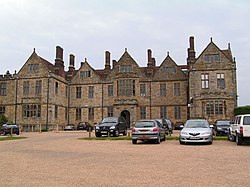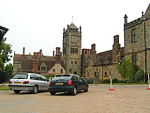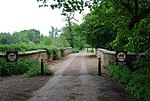Somerhill House
| Somerhill | |
|---|---|
 Somerhill House, June 2006 | |
| Former names | Somer Hill Summerhill Summer Hill |
| General information | |
| Architectural style | Jacobean |
| Address | Somerhill, Tonbridge, Kent, TN11 0NJ |
| Town or city | Tudeley, Kent |
| Country | United Kingdom |
| Coordinates | 51°10′59″N 0°18′00″E / 51.18306°N 0.30000°E |
| Current tenants | The Schools at Somerhill |
| Construction started | 1611 |
| Completed | c1613 |
| Renovated | 1879–97, 1988–91 |
| Owner | The Schools at Somerhill Charitable Trust |
| Technical details | |
| Floor count | Three |
| Design and construction | |
| Architect(s) | John Thorpe |
| Renovating team | |
| Architect(s) | Fielden and Mawson (1988–91) |
| Renovating firm | R. Durtnell & Sons, Brasted (1988–91) |
Somerhill House (
Somerhill housed a
Location
Somerhill House lies 1+1⁄2 miles (2.4 km) south of
Description
Somerhill is built of
As built, the house measured almost 100 feet (30 m) in depth internally.[5] The hall measures 23 feet (7.0 m) by 47 feet (14.3 m). To its north was a 22 feet (6.7 m) by 25 feet (7.6 m) drawing room. The dining room, located to the right of the hall measured 22 feet (6.7 m) by 33 feet (10 m).[5] As extended, Somerhill provides around 49,000 square feet (4,600 m2) of floorspace.[6]
The house shows the transition from medieval architecture, in which the hall was the main living and entertaining room, to the more modern plan, where the hall became a reception room. Somerhill is one of the earliest examples of this.[2] When built, this was an innovative design.[3]
History
17th century
The land that Somerhill was built on originally formed part of the estate of South Frith, one of two
Lord Clanricarde died in 1636, and Somerhill passed to his son
Following the
18th century
Dekins sold Somerhill to one Cave, who sold it in 1712 to John Woodgate of
19th century
In the spring of 1810,
Following the end of the
In 1842,
The lake at Somerhill, which Turner had painted in 1811, was used to supply ice for the house, as a watering place for the estate's
In 1866, Somerhill passed to Frederick's son
A
20th century

In 1912, there was an
Post-war, the house was the scene of much lavish entertaining. Lady Rosemary d'Avigdor-Goldsmid likened it to a hotel, "except that the guests didn't pay!" Amongst the distinguished visitors were
In 1976, Somerhill passed to Sir Henry's surviving daughter Chloe, who lived at Hadlow Place Farm, Hadlow. She sold Somerhill in 1981 and it was sold thrice more in the next eight years. A sale of the contents of Somerhill was held by Sotheby's on 23 and 24 June 1981.[35] It was bought by Mr and Mrs Watts who opened it for weddings parties etc. Somerhill was advertised for sale in May 1984 at a price in excess of £1,500,000.[6] Beginning in 1988,[2] the house was extensively restored with assistance from English Heritage. The works were undertaken by R. Durtnell & Sons of Brasted, who celebrated their 400th anniversary in 1991 with a party held at Somerhill as the restoration was completed.[3] Fielden and Mawson were the architects for the work.[2]
In 1993,
21st century
The reinstated central span opened in January 2001. The new sports hall was completed in 2002 at a cost of £1,400,000. An artificial turf pitch was added in 2003. In 2004, the bridge over the lake was repaired at a cost of £170,000, aided by a grant of £32,000 from Tunbridge Wells Borough Council.[3] In 2006, planning permission was granted for the conversion of the walled garden into a dining hall and indoor swimming pool. Work began the next year and was completed in January 2009.[3] The dining room and swimming pool were given a Design Award by Tonbridge Civic Society in 2009.[37] As a working school, Somerhill House is not normally open to the public. It has been open as part of Heritage Open Days. Somerhill House was open in 2006,[38] and also in 2010.[39] The grounds of Somerhill contain 152 acres (62 ha) of land.[3]
Listed buildings
The table below shows the status of the various listed buildings in the grounds of Somerhill House.
| Description | Grade | Date of listing | Photograph |
|---|---|---|---|
| Somerhill House | I.[40] | 20 October 1954.[2] | 
|
| Bridge over the lake | II.[41] | 24 August 1990.[41] | 
|
| Lake Cottage | II.[42] | 24 August 1990.[42] | 
|
| Terrace Walls and Sunken Lane | II.[43] | 24 August 1990.[43] | 
|
References
- ^ Clifford 1830, p. 153.
- ^ a b c d e f g h i j k l "Somerhill". English Heritage. Retrieved 8 December 2010.
- ^ a b c d e f g h i j k l m n o p q r s t u v w Huntingford, Diane (February 2009). "SOMERHILL HISTORY" (PDF). The Schools at Somerhill. Archived from the original (PDF) on 6 October 2011. Retrieved 8 December 2010.
- ^ a b Oswald 1933, p. 41.
- ^ a b c Britton 1832, p. 121.
- ^ a b Christopher Warman (23 May 1984). "A slab of history, all mods cons and a friendly ghost". Residential Property. The Times. No. 61838. London. col E, p. 28.
- ^ Burr 1766, p. 233.
- ^ Neve 1933, p. 53.
- ^ a b c Oswald 1933, p. 42.
- ^ a b Britton 1832, p. 120.
- ^ a b Clifford 1830, p. 154.
- ^ Colbran 1840, p. 332.
- ^ Colbran 1840, pp. 332–333.
- ^ Colbran 1840, p. 333.
- ^ Colbran 1840, pp. 333–334.
- ^ Colbran 1840, p. 334.
- ^ Hasted 1798, p. 235.
- ^ a b c Hasted 1798, p. 236.
- ^ Neve 1933, p. 54.
- ^ Burr 1766, p. 234.
- ^ Neve 1933, p. 46.
- ^ "Somerhill by Turner". Flickr. Retrieved 8 December 2010.
- ^ a b "Somer Hill, Tonbridge". National Galleries. Retrieved 2 December 2016.
- ^ Neve 1933, p. 47.
- ^ Neve 1933, p. 360.
- ^ "The Priory". Tonbridge Historical Society. Retrieved 26 December 2010.
- ^ "The Search for the Priory Coffin". Tonbridge Collectables. Retrieved 8 December 2010.
- ^ Robertson 1900, p. 95-101.
- ^ a b Thomson 1883, p. 173.
- ^ Thomson 1883, p. 174.
- ^ Dale 1967, p. 159.
- ^ "Leigh in the War, 1939–45" (PDF). Leigh and District Historical Society. September 1993. Archived from the original (PDF) on 17 June 2012. Retrieved 15 January 2010.
- ^ Memorial plaque to Sarah d'Avigdor-Goldsmid (plaque). All Saints Church, Tudeley. c. 1963. Retrieved 28 December 2010.
- ^ "All Saints' Tudeley". All Saints’ Tudeley. Retrieved 10 January 2010.
- ^ "Salerooms and Antiques". Property. The Times. No. 60955. London. 16 June 1981. col C, p. 21.
- ^ "About the Schools at Somerhill". The Schools at Somerhill. Retrieved 26 May 2016.
- ^ "Civic Society Design Awards 2009". Tonbridge Civic Society. Retrieved 27 December 2010.
- ^ "Heritage Weekend – 9 September 2006 – Tonbridge". The Best of Tonbridge. Retrieved 8 December 2010.
- ^ "Tunbridge Wells Heritage Open Days 2010". Tunbridge Wells Civic Society. Retrieved 8 December 2010.
- ^ "Monument details, Somerhill". Kent County Council. Retrieved 25 March 2013.
- ^ a b "Monument details, Lake Bridge". Kent County Council. Retrieved 25 March 2013.
- ^ a b "Monument details, Lake cottage". Kent County Council. Retrieved 25 March 2013.
- ^ a b "Monument details, Terrace Walls Around The South And East Sides Of Somerhill Including The Sunken Lane Approximately 5 Metres North Of The Somerhill Stable Yard". Kent County Council. Retrieved 25 March 2013.
Sources
- Britton, John (1832). Descriptive Sketches of Tunbridge Wells and the Calverley Estate. London: John Britton. (p 120, p 121)
- Burr, Thomas Benge (1766). The History of Tunbridge Wells. Tunbridge Wells: Thomas Benge Burr. (p 233, p 234)
- Clifford, J (1830). Guide of Tunbridge Wells. Tunbridge Wells: J Clifford. (p 154)
- Colbran, John (1840). Colbran's New Guide for Tunbridge Wells. Cornhill, London: A H Bailey & Co. (p 332 Archived 2011-09-30 at the Wayback Machine, p 333, p 334)
- Dale, Antony (1967) [1947]. Fashionable Brighton 1820–1860 (2nd ed.). Newcastle-upon-Tyne: Oriel Press Ltd. ISBN 0-85362-028-8.
- Hasted, Edward (1798). The History and Topographical Survey of the County of Kent, Volume V. Canterbury: W Bristow. (p 235, p 236)
- Neve, Arthur H (1933). The Tonbridge of Yesterday. Tonbridge: Tonbridge Free Press. (p 46, p 47, p 53, p 54, p 360)
- Oswald, Arthur (1933). Country Houses of Kent. London: Country Life Ltd. (p 41, p 42)
- Robertson, Maxwell Alexander (1866). English reports annotated, 1866-1900, Volume 1.
- Thomson, J Radford (1883). Pelton's Illustrated Guide to Tunbridge Wells. Tunbridge Wells: Richard Pelton. (p 173, p 174)

